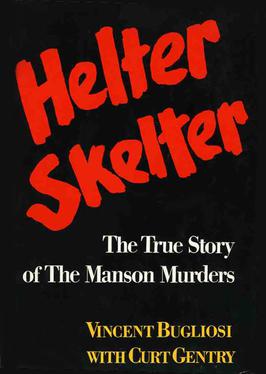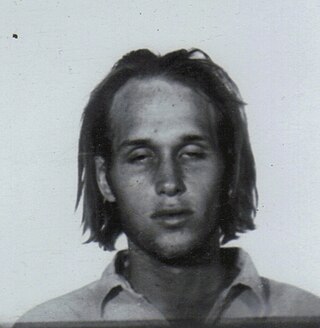
Charles Milles Manson was an American criminal, cult leader and musician who led the Manson Family, a cult based in California, in the late 1960s. Some of the members committed a series of at least nine murders at four locations in July and August 1969. In 1971, Manson was convicted of first-degree murder and conspiracy to commit murder for the deaths of seven people, including the film actress Sharon Tate. The prosecution contended that, while Manson never directly ordered the murders, his ideology constituted an overt act of conspiracy.

Patricia Dianne Krenwinkel is an American convicted murderer and former member of the Manson Family. During her time with Manson's group, she was known by various aliases such as Big Patty, Yellow, Marnie Reeves and Mary Ann Scott, but to The Family, she was most commonly known as Katie.

Susan Denise Atkins was an American convicted murderer who was a member of Charles Manson's "Family". Manson's followers committed a series of nine murders at four locations in California over a period of five weeks in the summer of 1969. Known within the Manson family as Sadie Mae Glutz or Sexy Sadie, Atkins was convicted for her participation in eight of these killings, including the most notorious, the Tate murders in 1969. She was sentenced to death, which was subsequently commuted to life imprisonment when the California Supreme Court invalidated all death sentences issued prior to 1972. Atkins was incarcerated until her death in 2009. At the time of her death, she was California's longest-serving female inmate, long since surpassed by fellow Manson family members Leslie Van Houten and Patricia Krenwinkel.

Leslie Louise Van Houten is an American convicted murderer and former member of the Manson Family. During her time with Manson's group, she was known by aliases such as Louella Alexandria, Leslie Marie Sankston, Linda Sue Owens and Lulu.

The Manson Family was a commune, gang, and cult led by criminal Charles Manson that was active in California in the late 1960s and early 1970s. The group at its peak consisted of approximately 100 followers, who lived an unconventional lifestyle, frequently using psychoactive drugs, including amphetamine and hallucinogens such as LSD. Most were young women from middle-class backgrounds, many of whom were attracted by hippie culture and communal living and then radicalized by Manson's teachings. The group is confirmed to have murdered 9 people, though they potentially killed up to 24.

"Helter Skelter" is a song by the English rock band the Beatles from their 1968 album The Beatles. It was written by Paul McCartney and credited to Lennon–McCartney. The song was McCartney's attempt to create a sound as loud and dirty as possible. It is regarded as a key influence in the early development of heavy metal. In 1976, the song was released as the B-side of "Got to Get You into My Life" in the United States, to promote the Capitol Records compilation Rock 'n' Roll Music.

Helter Skelter: The True Story of The Manson Murders is a 1974 book by Vincent Bugliosi and Curt Gentry. Bugliosi had served as the prosecutor in the 1970 trial of Charles Manson. The book presents his firsthand account of the cases of Manson, Susan Atkins, Patricia Krenwinkel, and other members of the self-described Manson Family. It is the best-selling true crime book in history.

Helter Skelter is a 1976 television film based on the 1974 book by prosecutor Vincent Bugliosi and Curt Gentry. In the United States, it aired over two nights. In some countries it was shown in cinemas, with additional footage including nudity, foul language, and more violence.
Linda Darlene Kasabian was an American woman known for being a member of the Manson Family, a cult led by Charles Manson in late-1960s–early-1970s California. She was present at both the Tate and LaBianca murders committed by the cult in 1969, but received immunity for her testimony as a key witness in District Attorney Vincent Bugliosi's prosecution of Manson and his followers.

Charles Denton "Tex" Watson is an American murderer who was a central member of the "Manson Family" led by Charles Manson. On August 9, 1969, Watson, Patricia Krenwinkel, and Susan Atkins murdered pregnant actress Sharon Tate, Jay Sebring, Wojciech Frykowski, Abigail Folger, and Steven Parent at 10050 Cielo Drive in Benedict Canyon, Los Angeles. The next night, Watson traveled to Los Feliz, Los Angeles, and participated in the murders of Leno and Rosemary LaBianca. Watson was convicted of murder in 1971 and sentenced to death. As a result of a 1972 California Supreme Court decision on the constitutionality in the state of the death penalty, he avoided execution but has remained incarcerated ever since.

Ronald W. Hughes was an American attorney who represented Leslie Van Houten, a member of the Manson Family. Hughes disappeared while on a camping trip during a ten-day recess from the Tate-LaBianca murder trial in November 1970. His body was found in March 1971, but his cause of death could not be determined. At least one Manson Family member has claimed that Hughes was murdered by the family in an act of retaliation. No one has been charged in connection with his death.

Spahn Ranch, also known as the Spahn Movie Ranch, was a 55-acre movie ranch in Los Angeles, California. For a period it was used as a ranch, dairy farm and later movie set during the era of westerns. After a decline in use for filming by the 1950s, its owner George Spahn established a stable for renting horses for riding on the varied acres. It became known in the late 20th century as the primary headquarters of Charles Manson and his cult followers, the "Manson Family", for much of 1967 and 1968. They were notorious for the Tate-LaBianca murders of August 1969.
The Helter Skelter scenario is an apocalyptic vision that was supposedly embraced by Charles Manson and members of his so-called Family. At the trial of Manson and three others for the Tate–LaBianca murders, the prosecution presented it as motivating the crimes and as an aspect of the case for conspiracy. Via interviews and autobiographies, former Family members related what they had witnessed and experienced of it.
Paul Alan Watkins was an American man who was a member of Charles Manson's "Family". In the period leading up to Manson's trial for the Tate–LaBianca murders, Watkins provided the prosecution with information that clarified the "Helter Skelter" motive. He is not to be confused with Tex Watson.

George Christian Spahn was an American rancher who once owned the Spahn Ranch near Chatsworth, Los Angeles. Spahn rented the ranch to the movie industry to film Westerns, and later allowed Charles Manson and his "Family" of followers to live at the site.
Catherine Share is an American criminal who is known as a former member of the Manson Family; she was convicted of witness intimidation in relation to the 1970 trial of the Tate-LaBianca murders. In 1971 she was convicted of armed robbery and served five years. Share was not directly involved in the Tate-LaBianca murders, for which Charles Manson and some of his followers were convicted and originally sentenced to death. She served 90 days for witness intimidation.

Steven Dennis "Clem" Grogan is an American convicted murderer and former member of the Manson Family. He was released from prison in 1985.

Helter Skelter is a 2004 television film written and directed by John Gray, based on the 1974 non-fiction book by Vincent Bugliosi and Curt Gentry about the murders of the Manson Family. The film is the second film to be based on the Charles Manson murders, following the 1976 two-part TV movie of the same name. Unlike the 1976 version, which focused mainly on the police investigation and the murder trial, this version focused mainly on Linda Kasabian's involvement with the Manson Family and their development.
The Tate–LaBianca murders were a series of murders perpetrated by members of the Manson Family during August 9–10, 1969, in Los Angeles, California, United States, under the direction of Tex Watson and Charles Manson. The perpetrators killed five people on the night of August 8–9: pregnant actress Sharon Tate and her companions Jay Sebring, Abigail Folger, and Wojciech Frykowski, along with Steven Parent. The following evening, the Family also murdered supermarket executive Leno LaBianca and his wife, Rosemary, at their home in the Los Feliz section of Los Angeles.

CHAOS: Charles Manson, the CIA, and the Secret History of the Sixties is a 2019 nonfiction book written by Tom O'Neill with Dan Piepenbring. The book presents O'Neill's research into the background and motives for the Tate–LaBianca murders committed by the Manson Family in 1969. O'Neill questions the Helter Skelter scenario argued by lead prosecutor Vincent Bugliosi in the trials and in his book Helter Skelter (1974). The book's title is a reference to the covert CIA program Operation CHAOS.














